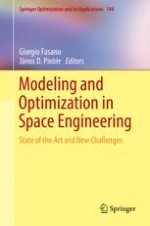
2019 | OriginalPaper | Buchkapitel
Control Propellant Minimization for the Next Generation Gravity Mission
verfasst von : Alberto Anselmi, Stefano Cesare, Sabrina Dionisio, Giorgio Fasano, Luca Massotti
Erschienen in: Modeling and Optimization in Space Engineering
Aktivieren Sie unsere intelligente Suche, um passende Fachinhalte oder Patente zu finden.
Wählen Sie Textabschnitte aus um mit Künstlicher Intelligenz passenden Patente zu finden. powered by
Markieren Sie Textabschnitte, um KI-gestützt weitere passende Inhalte zu finden. powered by